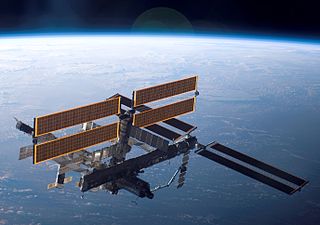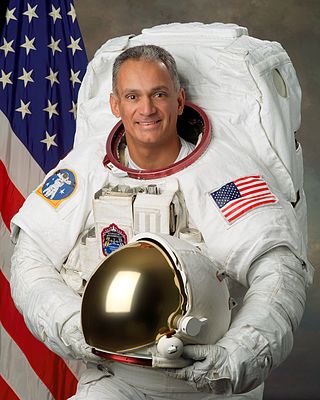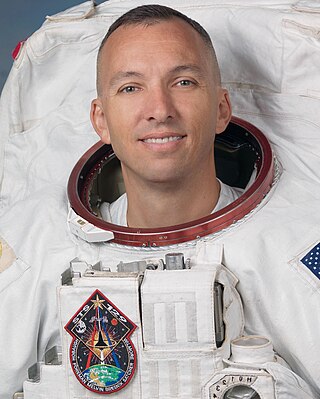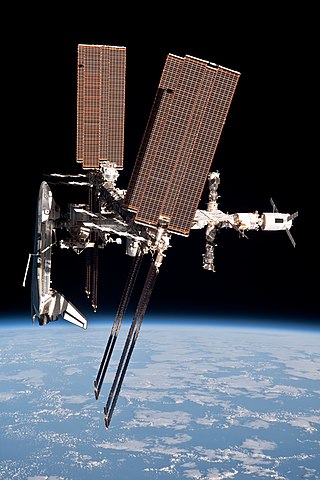
Extravehicular activity (EVA) is any activity done by an astronaut in outer space outside a spacecraft. In the absence of a breathable Earthlike atmosphere, the astronaut is completely reliant on a space suit for environmental support. EVA includes spacewalks and lunar or planetary surface exploration. In a stand-up EVA (SEVA), an astronaut stands through an open hatch but does not fully leave the spacecraft. EVAs have been conducted by the Soviet Union/Russia, the United States, Canada, the European Space Agency and China.

Michael López-Alegría is an astronaut, test pilot and commercial astronaut with dual nationality, American and Spanish; a veteran of three Space Shuttle missions and one International Space Station mission. He is known for having performed ten spacewalks so far in his career, presently holding the second longest all-time EVA duration record and having the fifth-longest spaceflight of any American at the length of 215 days; this time was spent on board the ISS from September 18, 2006, to April 21, 2007. López-Alegría commanded Axiom-1, the first ever all-private team of commercial astronaut mission to the International Space Station, which launched on April 8, 2022, and spent just over 17 days in Earth's orbit.

STS-72 was a Space Shuttle Endeavour mission to capture and return to Earth a Japanese microgravity research spacecraft known as Space Flyer Unit (SFU). The mission launched from Kennedy Space Center, Florida on 11 January 1996.

STS-92 was a Space Shuttle mission to the International Space Station (ISS) flown by Space Shuttle Discovery. STS-92 marked the 100th mission of the Space Shuttle. It was launched from Kennedy Space Center, Florida, 11 October 2000.

Patrick Graham Forrester is a NASA astronaut, engineer, and former Chief of the Astronaut Office. He is a retired United States Army colonel and Army aviator. He is married and has two children.

Scott Edward Parazynski is an American physician and a former NASA astronaut. A veteran of five Space Shuttle flights and seven spacewalks, Parazynski's latest mission was STS-120 in October 2007 – highlighted by a dramatic, unplanned EVA to repair a live solar array. In May 2016 he was inducted into the United States Astronaut Hall of Fame. He retired from NASA in March 2009 to pursue entrepreneurial opportunities in the private sector, and he is currently the CEO of a technology start-up. He is the first person to have both flown in space and summited Mount Everest, the highest point on Earth. He describes his life's experiences in his memoir The Sky Below.

Salizhan Shakirovich Sharipov is a Kyrgyz cosmonaut of Uzbek descent. Sharipov is a co-author and investigator for the Advanced Diagnostic Ultrasound in Microgravity project. He has been to space twice and has conducted two space walks. Sharipov retired on 18 July 2008.

Rex Joseph Walheim is a retired United States Air Force officer, engineer and NASA astronaut. He flew three Space Shuttle missions, STS-110, STS-122, and STS-135. Walheim logged over 566 hours in space, including 36 hours and 23 minutes of spacewalk (EVA) time. He was assigned as mission specialist and flight engineer on STS-135, the final Space Shuttle mission.

STS-115 was a Space Shuttle mission to the International Space Station (ISS) flown by Space ShuttleAtlantis. It was the first assembly mission to the ISS after the Columbia disaster, following the two successful Return to Flight missions, STS-114 and STS-121. STS-115 launched from LC-39B at the Kennedy Space Center on September 9, 2006, at 11:14:55 EDT.

Robert Shane Kimbrough is a retired United States Army officer and NASA astronaut. He was part of the first group of candidates selected for NASA astronaut training following the Space Shuttle Columbia disaster. Kimbrough is a veteran of three spaceflights, the first being a Space Shuttle flight, and the second being a six-month mission to the ISS on board a Russian Soyuz craft. He was the commander of the International Space Station for Expedition 50, and returned to Earth in April 2017. He is married to the former Robbie Lynn Nickels.

STS-116 was a Space Shuttle mission to the International Space Station (ISS) flown by Space Shuttle Discovery. Discovery lifted off on December 9, 2006, at 20:47:35 EST. A previous launch attempt on December 7 had been canceled due to cloud cover. It was the first night launch of a Space Shuttle since STS-113 in November 2002.

Soichi Noguchi is a Japanese aeronautical engineer and former JAXA astronaut. His first spaceflight was as a mission specialist aboard STS-114 on 26 July 2005 for NASA's first "return to flight" Space Shuttle mission after the Columbia disaster. He was also in space as part of the Soyuz TMA-17 crew and Expedition 22 to the International Space Station (ISS), returning to Earth on 2 June 2010. He is the sixth Japanese astronaut to fly in space, the fifth to fly on the Space Shuttle, and the first to fly on Crew Dragon.

Michael Edward Fossum is a former American astronaut, engineer, and the Chief Operating Officer of Texas A&M University at Galveston. He flew into space on board the NASA Space Shuttle missions STS-121 and STS-124 and served as a mission specialist of Expedition 28 and commander of Expedition 29 aboard the International Space Station.

Expedition 14 was the 14th expedition to the International Space Station (ISS). Commander Michael López-Alegría, and flight engineer Mikhail Tyurin launched from Baikonur Cosmodrome on 18 September 2006, 04:09 UTC, aboard Soyuz TMA-9. They joined Thomas Reiter, who had arrived at the ISS on 6 July 2006 aboard Space Shuttle Discovery during mission STS-121. In December 2006, Discovery mission STS-116 brought Sunita Williams to replace Reiter as the third member of Expedition 14. On 21 April 2007, López-Alegría and Tyurin returned to Earth aboard TMA-9. Landing occurred at 12:31:30 UTC.

John Daniel "Danny" Olivas is an American engineer and a former NASA astronaut. Olivas has flown on two space shuttle missions, STS-117 and STS-128. He performed EVAs on both missions, totaling 34hrs 28min.

Randolph James "Komrade" Bresnik is a retired officer in the United States Marine Corps and an active NASA astronaut. A Marine Aviator by trade, Bresnik was selected as a member of NASA Astronaut Group 19 in May 2004. He first launched to space on STS-129, then served as flight engineer for Expedition 52, and as ISS commander for Expedition 53.

Akihiko Hoshide is a Japanese engineer, JAXA astronaut, and former commander of the International Space Station. On August 30, 2012, Hoshide became the third Japanese astronaut to walk in space.

Michael Reed Barratt is an American physician and a NASA astronaut. Specializing in aerospace medicine, he served as a flight surgeon for NASA before his selection as an astronaut and has played a role in developing NASA's space medicine programs for both the Shuttle-Mir Program and International Space Station. His first spaceflight was a long-duration mission to the International Space Station, as a flight engineer in the Expedition 19 and 20 crew. In March 2011, Barratt completed his second spaceflight as a crew member of STS-133. Barratt pilots the SpaceX Crew-8 mission that launched on 4 March 2024.

STS-134 was the penultimate mission of NASA's Space Shuttle program and the 25th and last spaceflight of Space ShuttleEndeavour. This flight delivered the Alpha Magnetic Spectrometer and an ExPRESS Logistics Carrier to the International Space Station. Mark Kelly served as the mission commander. STS-134 was expected to be the final Space Shuttle mission if STS-135 did not receive funding from Congress. However, in February 2011, NASA stated that STS-135 would fly "regardless" of the funding situation. STS-135, flown by Atlantis, took advantage of the processing for STS-335, the Launch on Need mission that would have been necessary if the STS-134 crew became stranded in orbit.



























